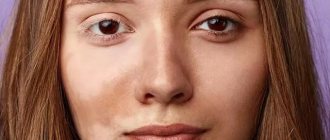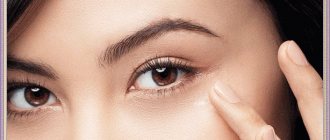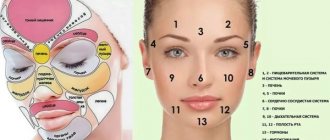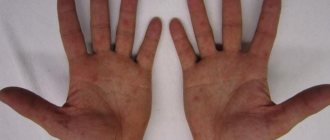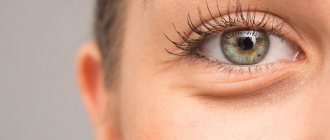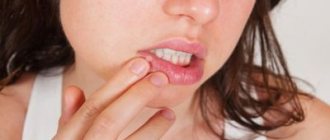A common cause of acne in women is hormonal disorders associated with diseases of the ovaries or adrenal glands. An excess of male hormones - androgens - is responsible for a number of unfavorable changes, including the development of acne.
With hormonal acne, women develop numerous purulent rashes on the neck, face and chin. Ulcers are difficult to treat. Treatment for acne caused by disruption of the endocrine system in women after thirty involves the use of creams, ointments, and sometimes hormonal drugs.
Acne after thirty. How do they manifest themselves and what is the reason?
The content of the article
Acne most often develops during puberty. These are the so-called juvenile acne. Their appearance is also associated with hormonal fluctuations, so as soon as the hormonal storm subsides, acne goes away.
Adult women and men also often come to dermatology offices with this problem. At the same time, patients who did not complain about skin problems in adolescence usually do not understand the reasons for the occurrence of purulent rashes and think that they have become infected with something. In fact, the appearance of acne was again triggered by hormones, but this is a disorder, not a natural process. In this case, you should not expect miracles in the form of independent normalization of hormonal levels. Acne in adults requires treatment.
Hormonal acne in women usually occurs on the face, chin, back and in the nasolabial triangle. Less commonly, changes in the skin appear in the lower jaw segment and on the neck. In turn, typical acne most often appears on the forehead and temples. Acne often appears suddenly, taking on the appearance of constantly incessant inflammatory changes.
The formation of acne is associated with improper differentiation of epidermal cells, the proliferation of bacteria, and also with an increased amount of sebum. Sebum production is regulated by the hormone testosterone, which is secreted by the adrenal glands in both women and men, or more precisely, by its active form, dihydrotestosterone. The activity of this hormone is determined by the presence of a special enzyme located in the skin, and the condition of the skin, in turn, depends on many environmental factors.
Among the most important causes of hormonal acne are poor diet, environment, and chronic stress.
Why does acne appear on the face?
Acne (pimples) is directly related to the active work of the sebaceous glands, hyperkeratosis, inflammation and increased colonization of propionibacteria. Excess sebum and dead epidermal cells clog pores, causing open (blackheads) and closed comedones to appear.
An inflammatory process may also begin in the skin, causing papules and pustules to appear. They can either independently or from comedones. Before deciding what to do with pimples* on the cheeks, you need to determine the cause of the rash, and there are several of them [4, 50]:
- Poor nutrition. Consumption of large amounts of fried, spicy, sweet foods, and dairy products increases the functioning of the sebaceous glands, causing rashes.
- Disruption of the digestive system. Allergies to certain foods and metabolic problems can cause rashes.
- Frequent stress and emotional overstrain. During stressful situations, the body produces large amounts of cortisol and adrenaline, which affect the functioning of the sebaceous glands.
- Insufficient or excessive hygiene, use of incorrect cosmetics. A connection has long been established between the appearance of acne and the use of certain types of cosmetics that are called comedogenic. They clog pores, causing acne*.
There are other reasons for the appearance of rashes on the cheeks - heredity, mechanical stress, bad habits, hormonal disorders. Sleeping on one side, using dirty makeup brushes or sponges, and the habit of constantly touching your face with your hands are all triggers for acne.
Development of acne as a consequence of endocrine disorders
Acne after thirty mainly affects women. As a result of disruption of the endocrine system in the body, patients experience an increased amount of androgens, the so-called male sex hormones. This factor causes acne.
In addition to acne, women develop hyperandrogenism, which is manifested by seborrhea and hirsutism, that is, hair growth in places typical of men, male pattern baldness, and sometimes even a deepening of the voice. These disorders lead to so-called masculinization.
Hirsutism
The production of excessive androgens in women may be adrenal or ovarian. In the first case, hyperandrogenism is caused by congenital adrenal hyperplasia or the formation of hormonally active adrenal tumors that intensively produce hormones. This condition is quite rare.
Typically, hyperandrogenism is associated with excess production of androgens by the ovaries, most often caused by polycystic ovary syndrome. This disease is a rather complex problem in gynecological endocrinology, which affects about 10-15% of women of childbearing age.
The content of androgens in the body is determined using laboratory tests. Women are also characterized by rare ovulations or even their complete absence, which often makes it difficult to get pregnant.
It is important to remember that the most common manifestation of hormonal imbalance is irregular menstruation. If this symptom occurs, you should always consult an endocrinologist.
Causes
Contrary to popular belief, milia are not acne , which are typical for people at puberty.
Attention! These formations are equally common in both young and older people. Formations arise for the following reasons:
- too much sun exposure ;
- disorders in the hormonal system;
- poor or unhealthy diet ;
- genetic predisposition;
- lack of vitamins;
- disturbance in the metabolic ;
- alcohol abuse;
- smoking;
- clogging of pores when using cosmetics;
- liver diseases.
Also, the appearance of such formations can be caused by improper functioning of the gastrointestinal tract and diseases of the pancreas.
How to treat hormonal acne in women
Acne caused by hormonal disorders should be treated by a gynecologist-endocrinologist or endocrinologist. However, patients usually go to see a dermatologist, who often cannot determine the cause of the disease and prescribe the correct treatment.
Treatment of hormonal acne in women can be local, when medications are applied directly to the affected areas of the skin, or systemic, using oral medications.
To relieve inflammation, experts recommend the use of antibiotics. A gynecologist-endocrinologist, after an appropriate examination, especially in pronounced cases of the disease, initiates hormonal treatment using hormonal contraceptive pills. Of course, it is used in women after twenty years, when puberty and restructuring of the body have completely occurred.
Hormonal birth control pills
Drugs are selected individually, taking into account hormonal imbalance, age, and concomitant diseases. The duration of administration is also regulated by the doctor.
To treat severe acne, a powerful drug containing a vitamin A derivative, isotretinoin, is used. Isotretinoin tablets should be taken only as directed and under the supervision of a physician; they are toxic and therefore are not intended for self-medication. Produced under the trade names: Roaccutane, Acnecutane.
During treatment, it is imperative to use contraception (hormonal or mechanical) both before and after the start of therapy, since the drugs have a teratogenic effect on the fetus.
Milia on the face: photo
In the photo below you can see what milia look like on the face. They can appear not only on the face, but also on the eyelids, under the eyes, and on the nose.
Acne skin care
In addition to a visit to a gynecologist-endocrinologist who will prescribe appropriate hormonal treatment, proper daily skin care for acne is very important:
- Choose a good acne treatment cream
. Preparations containing salicylic acid, alpha hydroxy acids, lactic, glycolic or azelaic acid have antimicrobial, anti-inflammatory, exfoliating and healing properties. - Thorough facial cleansing is necessary
. Using makeup removers alone is not enough; you also need to wash your face with plain water, toner or micellar liquid. After properly cleaning the skin, the cotton swab should be completely clean. - Use exfoliating products.
Peels are the most recommended. As a rule, one procedure per week is sufficient. However, peeling should not be used by people with delicate, sensitive skin as it may cause irritation. - Limit decorative makeup.
It is not recommended to use a thick layer of foundation and powder, which additionally blocks the openings of the sebaceous glands and increases inflammatory changes in the skin.
It is important to remember that treating acne in adults is a long and difficult journey, so you should be patient and work on leading a healthy lifestyle. The condition of the whole organism depends on how we live. Regular exercise, quitting smoking, and a well-balanced diet provide invaluable assistance in the process of acne therapy.
Proper nutrition
Prevention of milia
To prevent the occurrence of whiteheads on the face, you need to learn how to monitor the health of your skin, clean it properly, avoiding contamination, and buy suitable cosmetics. For example, if you have oily skin, it is better to refrain from using greasy, poorly absorbed creams. In this case, it is worth using gels.
To prevent the appearance of milia, it is also necessary to exfoliate the skin of the face and eye area. Apply cleansing masks, such as paraffin masks, which are good for eyelid skin.
And you definitely need to adjust your diet, minimizing fatty, sweet, flour, and fried foods.
In the medical department, everyone can undergo examination using the most modern diagnostic equipment, and based on the results, receive advice from a highly qualified specialist. We are open seven days a week and work daily from 9 a.m. to 9 p.m. Our specialists will help identify the cause of vision loss and provide competent treatment for identified pathologies.
You can find out the cost of a particular procedure or make an appointment at the Moscow Eye Clinic by calling 8 and 8 (499) 322-36-36 (daily from 9:00 to 21:00) or using the online registration form .
What procedures cannot be performed at home if you have acne* on your nose?
Steaming, scrubbing, and mechanical cleaning are the most common and quite dangerous scheme for fighting acne at home. If there are foci of inflammation on the skin, such manipulations only aggravate the situation. And here's why106:
- Local heating promotes the active proliferation of bacteria, causes pathogenic activity of the sebaceous glands, which in turn leads to an expansion of the acne area and causes additional inflammation.
- Using a scrub in the presence of foci of inflammation will only aggravate the problem and expand the affected area. Abrasive particles injure the skin. Scrubbing can only be done when acne is in remission.
- Home manual cleansing is a taboo for acne-affected skin. This procedure can be performed only in the absence of inflammatory elements and preferably in a cosmetologist’s office. Independent attempts to carry out deep cleaning can aggravate the problem, lead to the formation of large pores, the appearance of scars and age spots (post-acne).
It is better to consult a dermatologist or cosmetologist about home treatments. The specialist will prescribe the necessary course of treatment and help you choose the right cosmetics to care for problem skin.
Milia on the face: how to get rid of them
There are several ways to remove milia. They differ both in the complexity of the process and in cost.
Removal
Mechanical removal of milia is the simplest and most popular method, which is performed by a cosmetologist .
Before the procedure, the specialist cleanses the skin to avoid the possibility of infection, then makes a puncture and removes the contents of the acne .
This procedure should not be performed independently, since in some cases milia are very small in size, and when removed, a person can affect not only the milia itself, but also healthy tissue.
What to do if you have acne?
25.08.2021
Acne spoils the appearance of the face and also causes a lot of inconvenience to the owner. Firstly, acne looks terrible (but you shouldn’t be afraid or ashamed of it). Secondly, acne can be very painful. Thirdly, squeezing pimples is a very unpleasant thing.
Girls are already accustomed to the fact that before an important event a pimple will always pop up in some prominent place. However, this is a one-time event. And there are people who constantly suffer from a large number of rashes. And here the question arises: “What to do? How to get rid of them?
Let's start with the definition of acne .
What is acne?
Acne is a common skin disease that affects those areas of the skin where the largest number of sebaceous glands are concentrated.
Who is susceptible to such diseases?
Acne is the most popular disease among teenagers. After 25-26 years, the likelihood of acne decreases to 13 percent.
Causes of acne
Firstly, you need to understand one thing once and for all - acne never appears just like that, because it is a skin disease, and it always has its own reasons. And the appearance of acne on the nose does not mean that someone has certainly fallen in love with its owner. The main causes of acne :
- hormones : acne can appear in the premenstrual period, and often long-term skin diseases can appear due to hormonal imbalance;
- poor diet: acne occurs due to the consumption of low-quality foods. Again, there are individual intolerances to certain foods;
- allergies : allergic reactions are always accompanied by acne ;
- improper cosmetic care: many girls choose the wrong skincare products, which can cause acne . This is only possible for two reasons: the composition of the cosmetic product irritates the skin, so this is its usual reaction to an external irritant, or it may be an individual intolerance to individual components;
- stress: during prolonged stressful situations, sebum production increases;
- hygiene: how often do you forget to wash your face in the evening? Or how often do you change your pillowcases? Do you have a separate face ? Do you often touch your face with dirty hands? All this also affects the condition of the skin;
- long-term treatment: with long-term use of medications, the body begins to release harmful substances through the skin - it is difficult for the body to cleanse itself.
How to deal with acne?
In fact, the duration of treatment depends on many factors. Here it is worth taking into account your skin type, the stage of the disease, and the type of acne .
- Start practicing hygiene: do not neglect proper cleansing and care of your skin, do not touch your face with your hands, dry yourself with a clean towel, or even use only paper towels.
- Review your diet: analyze what constitutes the basis of your diet. Think carefully - after consuming which specific products acne worsens , try to exclude such a product and observe the changes.
- You should pay attention to both skincare cosmetics and regular cosmetics. Perhaps something doesn't suit your skin.
- Minimize worries and stress in the body, be less nervous.
- You can purchase special cosmetics designed to combat acne , which are selected according to your skin type.
- You can contact a doctor , who will prescribe tests to identify the exact diagnosis and problem, and then the specialist will select the correct treatment, which will be aimed at combating the source of the disease.
In fact, slow treatment, but effective, is better than fast, but short-lived treatment.
Thus, there are quite a lot of methods to combat acne , but it is not always possible to quickly find an effective treatment. Through mistakes and trials, you can find something that will help you get rid of the skin disease.
Published in Dermatology Premium Clinic
Causes of boils
The cause of the boil is a bacterial infection. Most often - Staphylococcus aureus. Bacteria enter the hair follicle, causing inflammation. The penetration of infection is facilitated by the presence of skin lesions, including:
- scuffs, scratches, abrasions. In men, the formation of boils on the face may be preceded by cuts when shaving;
- scratching for dermatological diseases;
- violation of the protective properties of the skin during prolonged contact with liquid. Therefore, increased sweating is a factor that increases the risk of developing a boil. Also, boils can occur inside the ear canal or in the nose, and the provoking factor is prolonged exposure to the skin of mucous or purulent secretions due to diseases, respectively, otitis (inflammation of the ear) or rhinitis (inflammation of the nasal mucosa);
- constant contamination of the skin, including those associated with professional activities (when the skin comes into contact with lubricating oils, cement, coal or lime dust, etc.).
Under normal conditions, the body's defense system prevents the development of inflammation. However, if the immune system is weakened, the risk of developing boils increases. In the case of multiple boils (furunculosis), the factor of decreased immunity is almost always present. The formation of boils is promoted by:
- chronic infectious diseases (tuberculosis, hepatitis, sinusitis, tonsillitis, bronchitis, pyelonephritis);
- HIV;
- hypothermia or, conversely, overheating. Hypothermia often becomes a factor provoking the formation of boils in adolescents;
- improper nutrition (depletion of the body, hypovitaminosis);
- diseases manifested in the form of metabolic pathologies (diabetes mellitus, endocrine disorders);
- treatment with drugs that suppress the immune system (used in the treatment of cancer and in some other cases);
- chronic fatigue;
- stress.
What does modern cosmetology offer?
Professional cosmetology offers a number of procedures that help improve the condition of acne skin56,13:
- Darsonvalization. The procedure is based on the effect of high-frequency currents of low strength on the skin. It has an antibacterial and soothing effect, reduces the appearance of acne.
- Facial cleansing (mechanical, atraumatic, vacuum, ultrasonic). Contact or non-contact skin cleansing helps remove impurities and toxins from pores, normalizes metabolic processes and blood supply to cells, and reduces the appearance of acne. The choice of a specific technology usually depends on the complexity of the disease. The procedure is not performed if there is inflammation.
- Cryotherapy. The essence of the procedure is to treat the skin with liquid nitrogen, which has a pronounced bactericidal effect. It dries the skin, suppresses pathogenic microflora, and relieves inflammation.
- Ozone therapy. The procedure is based on the subcutaneous injection of an ozone mixture into the affected areas of the skin. It helps destroy pathogenic microflora, stimulates the production of elastin and collagen, improves blood microcirculation, and activates metabolic processes in cells.
- Mesotherapy. The procedure involves the subcutaneous administration of “meso-cocktails”, which contain amino acids, minerals, antibiotics, and vitamins (the composition is selected individually by the doctor). It normalizes sebum secretion, tightens pores, and improves the overall condition of the skin.
- Plasma therapy. Subcutaneous injection of platelet-rich plasma into problem areas. According to reviews from professional cosmetologists and dermatologists, this procedure helps reduce the intensity of the inflammatory process, cell regeneration, and reduce the manifestations of post-acne.
All cosmetic procedures are permissible only in the absence of inflammation on the skin. Otherwise, even the safest ways to combat acne can greatly aggravate the problem.
